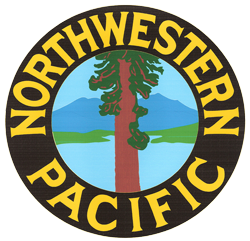NWP Railroad History

North Pacific Coast Railroad, Petaluma & Santa Rosa Railroad, Arcata and Mad River Railroad, California Western Railroad-Skunk Train, new NWP logo- adopted in 1996 by new publically owned NWP railroad, and are circled around original NWP logo.
The Railroad
The Northwestern Pacific Railroad,the ‘Redwood Empire Route’, played a major role in the growth of Northern California. The line was created in 1907 through the consolidation of six separate picturesque railroad companies held by the Santa Fe and Southern Pacific railroads. At its height, the Northwestern Pacific Railroad was an amalgamation of some sixty different companies. Some of the forerunners built extensive and substantial operating lines. Others, were short lines such as the many logging lines in the Humboldt Bay region. Nearly a third consisted of companies which incorporated but never laid a foot of track. All of them contributed, in some fashion, to the rich heritage of the NWP.
Diversity was a key word in the history of Redwood Empire railroading. Gauges varied from the Sonoma Prismoidal, an early wooden monorail, to the odd-gauged logging lines, many built to accommodate their four-legged motive power. In between lay the two foot Sonoma Magnesite RR, the first-class narrow gauge North Pacific Coast and, of course, the more common standard gauge lines. Power was supplied by horse, mules, oxen, steam, electricity, and internal combustion engines, both gas and diesel.
The NWP, with its affectionate ‘Nowhere in Particular’ nickname, operated standard gauge, narrow gauge, ferry steamboats and car floats, electric 3rd rail and overhead trolley interurbans, a streamlined ‘name’ train along with unusual connectors such as funiculars and scenic tourist railways. This transportation network in the pre-World War II years many claimed was too far ahead of its time. Rarely is so much fascinating diversity found in the origins of one company.
Since 1929, when Southern Pacific bought the Santa Fe’s equal interest in the line, the NWP has been a wholly-owned subsidiary of SP. In 1984, the trackage for Outlet, near Willits, north to Korblex was sold to a new company, the Eureka Southern RR, later named the North Coast RR. In 1996, the North Coast RR and the former “south end” of the Southern Pacific-owned NWP became the “new” Northwestern Pacific Railroad under public ownership. The new NWP’s goals include handling more freight by rail along the Highway 101 corridor, establishing passenger excursion trains, and eventually providing regular passenger commute service.
The Northwest Coast is the coastal regions of the Pacific Northwest and the Northwest Plateau (also commonly known as “The Interior” in British Columbia and the Inland Empire in the United States) is the inland regions. The term “Pacific Northwest” should not be confused with the Northwest Territory (also known as the Great Northwest, a historical term in the United States) or the Northwest Territories of Canada.
A key aspect of the Pacific Northwest is the US–Canada international border, which the United States and the United Kingdom established at a time when the region’s inhabitants were composed mostly of Indigenous peoples. The border — in two sections, along the 49th parallel south of British Columbia and the Alaska Panhandle west of northern British Columbia — has had a powerful effect on the region.
Definitions of the Pacific Northwest region vary and there is no commonly agreed upon boundary, even among Pacific Northwesterners. A common conception of the Pacific Northwest includes the U.S. states of Oregon and Washington as well as the Canadian province of British Columbia. This definition is often restricted further to include only the coastal areas west of the crest of the Cascade Mountains and Canadian Coast Mountains.
1996 Northwestern Pacific System Map

1930 Northwestern Pacific System Map

